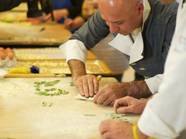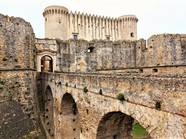Reports from The Gourmet Retailer show that stats from the National Cancer Institute do not look promising: “during 2009 alone, there will be 192,370 women diagnosed with breast cancer, and 40,170 women that will die from it. With the disease affecting so many lives, it is important to think about prevention and the best way we can help ourselves prevent all types of cancer, including breast cancer, is through our lifestyle and diet choices.
The American Dietetic Association agrees, stating that fruits and vegetables provide a complex
combination of vitamins, minerals, fiber and phytonutrients, and are low in fat -- all properties that make them ideal for helping to prevent cancer. It is never too late to adopt a healthier diet, especially when statistics indicate that almost 13 percent of all American girls born today will be diagnosed with breast cancer at some point in their lives.”
Dr. John H Maher, who writes and teaches regularly on nutrition for health professionals and is co-founder of BioPharma Scientific and creator of "The SuperFood Solution™: Lifelong Wellness Made Easy,” has these suggestions for a preventive diet:
Yellow/orange vegetables -- Eating foods high in beta- carotene has been linked in many studies to lower rates of breast cancer. Tip: Baby carrots beta-carotene is more absorbable then regular carrots and carrots beta-carotene is 500% more absorbable than in raw carrots.
Cruciferous vegetables-- Radish, broccoli, cauliflower, rutabaga, cabbage, turnips, turnip greens, contain indole -3-carbinol, which lowers women's levels of a type of estrogen that may promote breast cancer. Tip: Look for BroccoSprouts, a brand of broccoli sprouts with megalevels of SGS, a compound that fights mammary tumors in mice.
Organic hormone free milk -- Why not fat-free milk? Because there's an intriguing compound in milk fat (including butter)-- conjugated linoleic acid -- that fights breast cancer cells in test tubes and animals.
Tomatoes -- Whether cooked, dried, in soups, juice and sauces, even in Ketch-up form, tomatoes are filled up on a compound called lycopene. Diets high in lycopene are linked to lower rates of breast and prostate cancer.
Grapes -- They have cancer-fighting antioxidant power.
Cold water fish (salmon ,tuna, anchovies, swordfish, polluck, crab, sardines) and omega-3 rich nuts and seeds (walnut, pumpkin, flax) -- Research suggests that women with higher tissue levels of omega-3s have lower rates of breast cancer.
Vitamin D -- Exposing yourself to sunlight is the most important source of vitamin D because sunlight is far more likely to provide you with your vitamin D requirement than food is.
Dark cherries -- Cherries are a top source of a compound that may inhibit mammary cancer in rats.
Limonoids -- Compounds found in the peel and white membrane of oranges, inhibit breast cancer in test tubes. Eat whole fruit oranges and tangerines. Look for herbal teas made w/ orange lemon peel. Use real orange and lemon oils in cooking and health drinks.
Whole grains vs. refined grains -- At least one study has shown that women who ate the most refined grains had more breast cancer. Another study showed women who ate one serving a day of a cereal high in wheat bran lowered their level of breast cancer -promoting estrogen.
Butter vs. margarine -- One study suggests that a diet higher in trans fats may increase the risk of breast cancer. Margarine, most french fries, both frozen and fast-food, and many processed and fried foods made with hydrogenated fats are a top trans fat source. If you prefer margarine, use a trans-fat free brand.
Green tea – No matter if hot or cold, green tea is rich in EGCG, a compound that inhibits breast cancer cells in mice. Caffienated brands have twice as much potency as uncaffienated. And most bottled brands have little. Mix with herbal teas and lemon peel for taste.
Olive oil -- Extra-virgin olive oil lowers the risk of developing breast cancer in those who carry a particular gene involved in about 20 to 30 percent of breast cancers.
Garlic -- Kills breast cancer cells in the test tube and maybe in you. But if you're going to cook garlic, always peel and chop, then let it rest for 10 to 15 minutes before you heat. Heating right away doesn't allow time for the cancer-fighting compounds to develop.
Flaxseed -- It has 75 times more lignin precursors, compounds that inhibit mammary tumors in animals. Sprinkle ground flaxseeds onto your hot or cold cereal, add flaxseeds to your homemade muffin, cookie or bread recipe and give cooked vegetables a nuttier flavor by sprinkling some of them on top.
Soy -- Isoflavinoids work as weak estrogens, blocking the more powerful estrogens from stimulating estrogen sensitive cancer cells.
Phyto herbs -- Like don quai, fennel, black cohosh are also weak estrogens that compete with stronger estrogens for estrogen receptor sites.








































 since 2001, Maurizio continues to innovate and perfect his specialty, Northern Italian cuisine, while overseeing a staff of thirty cooks in his kitchen.
since 2001, Maurizio continues to innovate and perfect his specialty, Northern Italian cuisine, while overseeing a staff of thirty cooks in his kitchen.